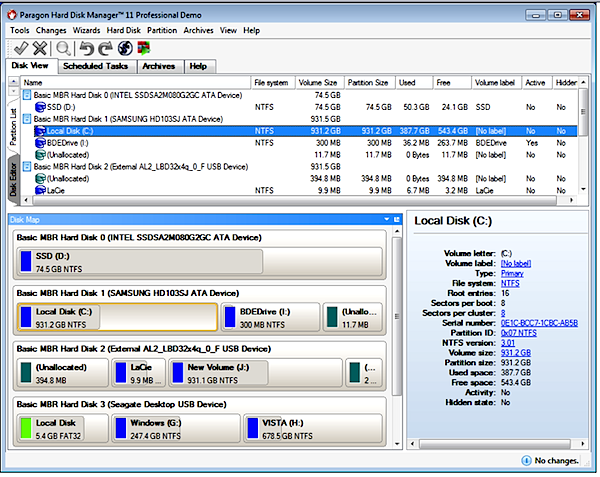
More than likely, the local disk is not going to have significant contention from many applications accessing the same drive. It is very likely that local disk performance is going to be nowhere near the theoretical performance of the drive, given that the data will not likely be allocated sequentially.
#SEAGATE DISK MANAGER 9.5 WINDOWS#
I am not a big fan of the Windows NTFS file system given the performance I have seen, and given the data and metadata allocation algorithms and the lack of high-speed streaming I/O bandwidth support. File System Data and Metadata Fragmentation It is pretty easy to oversubscribe the bandwidth of a storage system in a virtual environment. Of course, this is not seriously oversubscribed, but if everyone is trying to stream HD video you are going to get a large number of complaints. Having a RAID controller with, for example, 5 GB/sec of bandwidth is not going to work if 200 users need 200 different datasets simultaneously and want 30 MB/sec (200*30=6000 MB/sec and the controller does 5120 MB/sec). Of course, file systems do not necessarily allocate data and sequentially stream it, and very few applications that run locally must sustain more than 100 MB/sec, but I think it is important to understand what users need as well as the total required bandwidth across systems to be virtualized. For each local disk you are getting more than 100 MB/sec if you are streaming data. The average disk performance for a Seagate Enterprise 2.5 inch 10K drive is about 130 MB/sec, and a Seagate 3 TB 3.5 inch enterprise SATA/SAS drive is about 112 MB/sec. The bandwidth to storage is also something to consider when planning for virtualization. Contention can be mitigated, but it is difficult to fully determine the contention without a good understanding of the cache usage. Of course, in most virtualized systems you are running on storage controllers often with large caches, which can make a big difference. Your application does not have a dedicated disk drive, and the total number of IOPS for all the users running MIGHT be less than the 100 you had. In contrast, if you are on a virtualized system, you are very likely contending with many other users. You have 8 MB, maybe 16MB or even 64MB, of disk cache, and the disk you are using can likely support 100 random IOPS. You might be running applications in the background, but most likely you and the application you are running in the foreground are consuming most of the disk drive. If you are the only user on the system, you have full, un-contested access to the disk drive. File system data and metadata fragmentation.These four issues are paramount and must be considered as well: However, that is far from the only issue. One key issue is the latency on your network and to the storage that the virtualized user will be accessing as compared to the local storage. This is not going to change, so latency must be considered. We all know that the seek+latency on a standard enterprise SATA drive is around 4.16 ms for seek and between 8.5ms (read) and 9.5ms (write) depending on the drive manufacturer. Here, network performance and, more importantly, network latency is critical. On a virtualized system, the user boots up over the network and accesses applications and data over the network. In a nonvirtualzaed environment, each user has local storage for at least booting his system and very often for his data as well. One major tradeoff of virtualizing systems is that you are trading local bandwidth for network bandwidth. Wipe technology: Toshiba's unique technology which automatically erases data when an HDD is accessed by an unregistered system.Storage planning for virtualized systems requires some careful thinking about the issues that will impact users.Sanitize Device Feature set is the standard prescribed by T10(SAS) and T13(SATA) committees of American National Standards Association(ANSI), which makes it possible to invalidate the data recorded on the magnetic disks at a blink. SIE is compatible with Sanitize Device Feature set. Federal Information Processing Standards 140-2.

#SEAGATE DISK MANAGER 9.5 SOFTWARE#
Available storage capacity (including examples of various media files) will vary based on file size, formatting, settings, software and operating system and/or pre-installed software applications, or media content.

A computer operating system, however, reports storage capacity using powers of 2 for the definition of 1GB = 230 = 1,073,741,824 bytes and therefore shows less storage capacity.


 0 kommentar(er)
0 kommentar(er)
